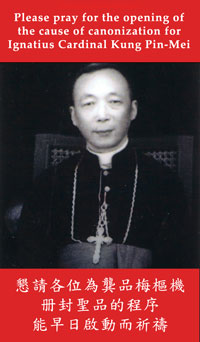Homily of Ignatius Cardinal Kung
At His First Holy Mass as Cardinal
in His Titular Church of St. Sixtus
Rome, July 1, 1991
![]()
Dear brother Bishops, Fathers, Sisters and all the faithful,
There is a special, unique and intimate relationship between every Cardinal and the Bishop of Rome - the Pope. Every Cardinal becomes a 'parish priest of Rome" and he has a church of his own although it is only nominal, or his "titular" church. After the Holy Father gave me the red hat of a Cardinal on June 28th, he assigned me to be the parish priest of St. Sixtus Church. This was a great honor to me. It has a profound meaning for me to be assigned as the honorary parish priest of St. Sixtus Church, the church of a Pope and martyr.
St. Sixtus II was a Pope during the years 257-259, and suffered martyrdom for the Lord, and was buried in St. Callistus Cemetery. It is said that when he was arrested and was being taken to be executed, he met his deacon, St. Laurence, who was waiting for him at the beginning of the Appian Way. St. Laurence said to the Pope, "Oh, Father! Why do you go to the execution alone without bringing me with you?" The Pope answered, "Soon you also will be arrested and the martyrdom you suffer will be greater than mine." And we all know that St. Laurence was roasted to death. Later, the bones of St. Sixtus and several other Popes and bishops were buried in the first little chapel on the left side of this church and there was an old monument in memory of them. Even now, we can still see the ancient church of the fifth century even though it has been repaired during the past fifteen centuries.
St. Dominic lived here for a period of time and performed at least four important miracles here. He brought three persons back to life. Angels came here to distribute bread in the refectory. The Dominican Sisters here still take their meals in this same refectory. I feel it is a great honor to have become the honorary parish priest of this church.
With profound significance in his choice, the Pope assigned me to be the honorary parish priest of this church. The Holy Father wants us to understand that the Church has suffered persecution from the very beginning. This was also the main idea of my sermon to the Chinese Catholics to whom I spoke yesterday. The Appian Way was one of the chief roads in ancient Rome. St. Peter, St. Paul and many other martyrs or confessors traveled along it and left their footprints on that road. Some of them, such as Pope St. Sixtus, left the traces of their chains fastened on their feet. The Roman Church in the third century and the Church in China in the twentieth century are separated by eighteen centuries and are thousands of miles apart, but at the same time, they both have a deeply intimate relationship. Both of them constitute the Church of Christ. Christ founded only one Church on earth, the Church built on St. Peter, the Rock. In both places, the Church was destined to be persecuted.
It is my deep hope that this time when I come to Rome to receive the honor of being a Cardinal, a still deeper bond will be forged with the See of Peter. Because I was nominated to be the honorary parish priest of St. Sixtus, an even closer bond shall unite us with the See of Rome. We pray to be faithful unto death. As the Holy Father has said, "We do not hesitate to shed our blood. The blood may be shed; the head may be cut off, but our union with the Pope can never be broken.' This is my final word to you. May God bless you!




